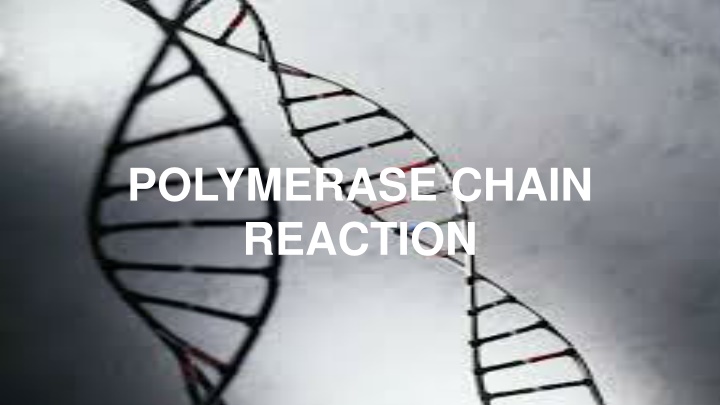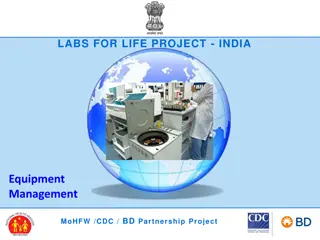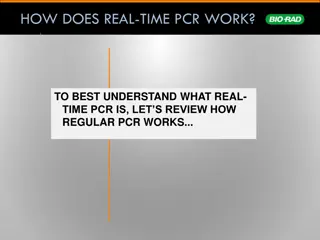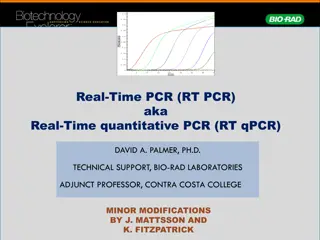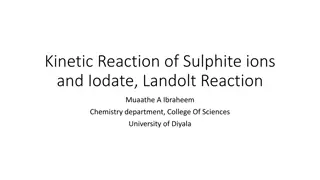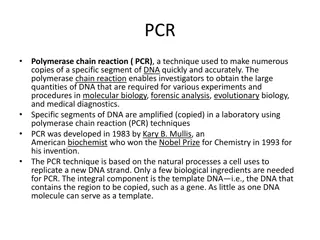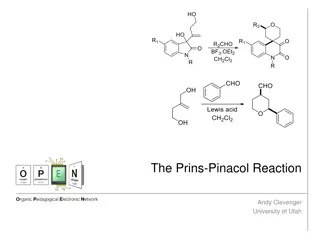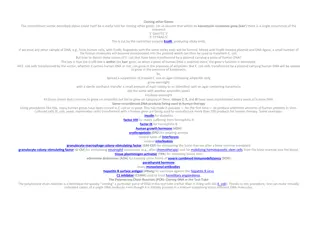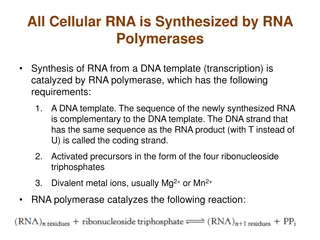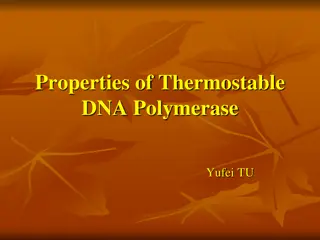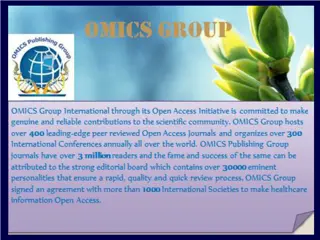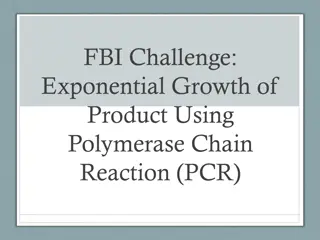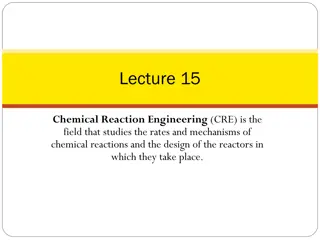Polymerase Chain Reaction (PCR) Overview
Polymerase chain reaction (PCR) is a pivotal molecular biology technique for amplifying DNA sequences. Developed in 1983 by Kary Mullis, PCR has revolutionized various scientific fields due to its versatility, accuracy, and efficiency. This technique involves amplifying specific DNA segments through repetitive cycles of denaturation, annealing, and extension, allowing the generation of millions of copies from a single or few DNA templates. PCR is instrumental in applications like DNA cloning, genetic testing, forensic analysis, and pathogen detection, contributing significantly to advancements in biotechnology and medical diagnostics.
Download Presentation

Please find below an Image/Link to download the presentation.
The content on the website is provided AS IS for your information and personal use only. It may not be sold, licensed, or shared on other websites without obtaining consent from the author.If you encounter any issues during the download, it is possible that the publisher has removed the file from their server.
You are allowed to download the files provided on this website for personal or commercial use, subject to the condition that they are used lawfully. All files are the property of their respective owners.
The content on the website is provided AS IS for your information and personal use only. It may not be sold, licensed, or shared on other websites without obtaining consent from the author.
E N D
Presentation Transcript
POLYMERASE CHAIN REACTION
CONTENTS Definition History Requirments for PCR Steps Components and reagents used Thermal cycler Procedure Stages Applications Advantages Disadvantages
DEFINITION Polymerase chain reaction (PCR) is a technique used in molecular biology to amplify a single copy or a few copies of a segment of DNA across several orders of magnitude, generating thousands to millions of copies of a particular DNA sequence. It is an easy, cheap, and reliable way to repeatedly replicate a focused segment of DNA, a concept which is applicable to numerous fields in modern biology and related sciences.
HISTORY Developed in 1983 by Kary Mullis, PCR is now a common and often indispensable technique used in clinical and research laboratories for a broad variety of applications. These include DNA cloning for sequencing, gene cloning and manipulation, gene mutagenesis construction of DNA-based phylogenies, or functional analysis of genes; diagnosis and monitoring of hereditary diseases amplification of ancient DNA analysis of genetic fingerprints for DNA profiling (for example, in forensic science and parentage testing) and detection of pathogens in nucleic acid tests for the diagnosis of infectious diseases. In 1993, Mullis was awarded the Nobel Prize in Chemistry along with Michael Smith for his work on PCR.
REQUIRMENTS OF PCR Heat-stable DNA polymerase(such as Taq polymerase) An enzyme (originally isolated from the thermophilic bacterium Thermus aquaticus). DNA polymerase (enzymatically assembles a new DNA strand from free nucleotides, the building blocks of DNA, by using single-stranded DNA as a template and DNA oligonucleotides). The primers (to initiate DNA synthesis).
STEPS In the first step, the two strands of the DNA double helix are physically separated at a high temperature in a process called DNA melting. In the second step, the temperature is lowered and the two DNA strands become templates for DNA polymerase to selectively amplify the target DNA. Selectivity of PCR results from the use of primers that are complementary to the DNA region targeted for amplification under specific thermal cycling conditions.
COMPONENTS AND REAGENTS DNA template that contains the DNA target region to amplify DNA polymerase, an enzyme that polymerizes new DNA strands; heat-resistant Taq polymerase is especially common, as it is more likely to remain intact during the high-temperature DNA denaturation process Deoxynucleoside triphosphates, or dNTPs (sometimes called "deoxynucleotide triphosphates" nucleotides containing triphosphate groups), the building blocks from which the DNA polymerase synthesizes a new DNA strand
Two DNA primers that are complementary to the 3' (three prime) ends of each of the sense and anti-sense strands of the DNA target (DNA polymerase can only bind to and elongate from a double-stranded region of DNA without primers there is no double-stranded initiation site at which the polymerase can bind) specific primers that are complementary to the DNA target region are selected beforehand, and are often custom-made in a laboratory or purchased from commercial biochemical suppliers
Buffer solution: providing a suitable chemical environment for optimum activity and stability of the DNA polymerase Bivalent cations :typically magnesium (Mg) or manganese (Mn) ions Mg2+ is the most common, but Mn2+ can be used for PCR-mediated DNA mutagenesis, as a higher Mn2+ concentration increases the error rate during DNA synthesis Monovalent cations: typically potassium (K) ions
THERMAL CYCLER The reaction is commonly carried out in a volume of 10 200 l in small reaction tubes (0.2 0.5 ml volumes) in a thermal cycler. The thermal cycler heats and cools the reaction tubes to achieve the temperatures required at each step of the reaction Many modern thermal cyclers make use of the Peltier effect, which permits both heating and cooling of the block holding the PCR tubes simply by reversing the electric current. Thin-walled reaction tubes permit favorable thermal conductivity to allow for rapid thermal equilibration. Most thermal cyclers have heated lids to prevent condensation at the top of the reaction tube. Older thermal cyclers lacking a heated lid require a layer of oil on top of the reaction mixture or a ball of wax inside the tube.
PROCEDURE Typically, PCR consists of a series of 20 40 repeated temperature changes, called cycles, with each cycle commonly consisting of two or three discrete temperature steps.The cycling is often preceded by a single temperature step at a very high temperature >90 by one hold at the end for final product extension or brief storage. The temperatures used and the length of time they are applied in each cycle depend on a variety of parameters, including the enzyme used for DNA synthesis. (194 F) and followed The concentration of bivalent ions and dNTPs in the reaction, and the melting temperature (Tm) of the primers.The individual steps common to most PCR methods are as follows.
Initialization: This step is only required for DNA polymerases that require heat activation by hot-start PCR. It consists of heating the reaction chamber to a temperature of 94 96 98 (208 F) if extremely thermostable polymerases are used, which is then held for 1 10 minutes. Denaturation: This step is the first regular cycling event and consists of heating the reaction chamber to 94 98 for 20 30 seconds. This causes DNA melting, or denaturation, of the double-stranded DNA template by breaking the hydrogen bonds between complementary bases, yielding two single- stranded DNA molecules. (201 205 F), or (201 208 F)
Annealing: In the next step, the reaction temperature is lowered to 50 65 (122 149 F) for 20 40 seconds, allowing annealing of the primers to each of the single- stranded DNA templates. Two different primers are typically included in the reaction mixture one for each of the two single-stranded complements containing the target region. The primers are single-stranded sequences themselves, but are much shorter than the length of the target region, complementing only very short sequences at the 3' end of each strand.
Extension/elongation: The temperature at this step depends on the DNA polymerase used; the optimum activity temperature for Taq polymerase is approximately 75 80 temperature of 72 (162 F) is commonly used with this enzyme. In this step, the DNA polymerase synthesizes a new DNA strand complementary to the DNA template strand by adding free dNTPs from the reaction mixture that are complementary to the template in the 5'-to-3' direction, condensing the 5'-phosphate group of the dNTPs with the 3'-hydroxy group at the end of the nascent (elongating) DNA strand. The precise time required for elongation depends both on the DNA polymerase used and on the length of the DNA target region to amplify. (167 176 F) though a
STAGES BASED ON REACTION PROGRESS As with other chemical reaction, the reaction rate and efficiency of PCR are affected by limiting factors. Thus, the entire PCR process can further be divided into three stages based on reaction progress Exponential amplification: At every cycle, the amount of product is doubled (assuming 100% reaction efficiency). The reaction is very sensitive: only minute quantities of DNA must be present. Leveling off stage: The reaction slows as the DNA polymerase loses activity and as consumption of reagents such as dNTPs and primers causes them to become limiting. Plateau: No more product accumulates due to exhaustion of reagents and enzyme.
APPLICATIONS Medical applications PCR has been applied to a large number of medical procedures: The first application of PCR was for genetic testing. PCR can also be used as part of a sensitive test for tissue typing, vital to organ transplantation
Research applications PCR allows rapid production of short pieces of DNA, even when not more than the sequence of the two primers is known. This ability of PCR augments many methods, such as generating hybridization probes for Southern or northern blot hybridization
Tissues (or even individual cells) can be analyzed at different stages to see which genes have become active, or which have been switched off. This application can also use quantitative PCR to quantitate the actual levels of expression
MICROBIOLOGY PCR is a highly valuable technique in microbiology as it allows crucial observations for organism detection. Organisms such as Mycobacterium tuberculosis can be studied effectively with the help of genotyping. This allows early identification and treatment and greatly impacts public health monitoring.
FORENSIC SCIENCE With the advent of PCR-based DNA fingerprinting, PCR became an invaluable tool in forensic investigations. Using DNA fingerprinting, tiny fragments of DNA can be isolated from a crime scene and compared to a huge database of DNA of convicts or criminals. It is also useful in ruling out suspects as part of an investigation. DNA fingerprinting is also used in paternity testing, where the DNA from an individual is matched with that of his possible children, siblings, or parents.
ENVIRONMENTAL MICROBIOLOGY The PCR technique has been successfully used to explore many issues in environmental microbiology. Some of its environmental applications are listed below: Sensitive detection of degrading microorganisms in toxic waste and pollutants can be achieved using PCR, which helps efficient biodegradation and bioremediation at the polluted sites. A gene probe-based PCR method has been developed by researchers for the detection of indicator bacteria such as coliforms in water supplies, thus supporting measures that enhance water safety. PCR is also used to detect and monitor water-borne microbial pathogens, which pose a major public health hazard.
Advantages PCR has a number of advantages. It is fairly simple to understand and to use, and produces results rapidly. The technique is highly sensitive with the potential to produce millions to billions of copies of a specific product for sequencing, cloning, and analysis. qRT-PCR shares the same advantages as the PCR, with an added advantage of quantification of the synthesized product. Therefore, it has its uses to analyze alterations of gene expression levels in tumors, microbes, or other disease states.
DISADVANTAGES One major limitation of PCR is that prior information about the target sequence is necessary in order to generate the primers that will allow its selective amplification.This means that, typically, PCR users must know the precise sequence(s) upstream of the target region on each of the two single-stranded templates in order to ensure that the DNA polymerase properly binds to the primer- template hybrids and subsequently generates the entire target region during DNA synthesis. Like all enzymes, DNA polymerases are also prone to error, which in turn causes mutations in the PCR fragments that are generated
